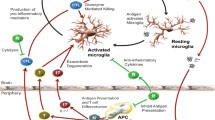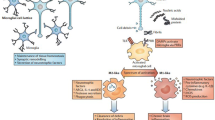Abstract
Neurodegenerative and neuropsychological disorders are becoming a greater proportion of the global disease burden; however the pathogenic mechanisms by which these disorders originate and contribute to disease progression are not well-described. Increasing evidence supports neuroinflammation as a common underlying component associated with the neuropathological processes that effect disease progression. This collection of articles explores the role of adaptive immunity in autoimmunity, neurodegeneration, neurotrauma, and psychological disorders. The section emphasizes the interactions of T cells with innate cellular responses within the CNS and the effects on neurological functions. One recurrent theme is that modified and aggregated self-proteins upregulate innate-mediated inflammation and provide a permissive environment for polarization of T cells to proinflammatory effector cells. Moreover, infiltration and reactivation of those T effector cells exacerbate neuroinflammation and oxidative stress to greater neurotoxic levels. Another recurrent theme in these disorders promotes diminished regulatory functions that reduce control over activated T effector cells and microglia, and ultimately augment proinflammatory conditions. Augmentation of regulatory control is discussed as therapeutic strategies to attenuate neuroinflammation, mitigate neurodegeneration or neuronal dysfunction, and lessen disease progression.
Similar content being viewed by others
References
Carare RO, Hawkes CA, Weller RO (2014) Afferent and efferent immunological pathways of the brain. Anatomy, function and failure. Brain Behav Immun 36:9–14
Chin JH, Vora N (2014) The global burden of neurologic diseases. Neurology 83:349–351
Debnath M (2015) Adaptive immunity in schizophrenia: functional implications of T cells in the etiology, Course and Treatment. J Neuroimmune Pharmacol. doi:10.1007/s11481-015-9626-9
Dua T, Garrido Cumbrera M, Mathers C, Saxena S (2006) Chapter 2. Global buden of neurological disorders: estimates and projections. In: Neurological Disorders: Public Health Challenges, pp 26–39. Geneva, Switzerland: World Health Organization Press.
de Graaf MT, Smitt PA, Luitwieler RL, van Velzen C, van den Broek PD, Kraan J, Gratama JW (2011) Central memory CD4+ T cells dominate the normal cerebrospinal fluid. Cytometry B Clin Cytom 80:43–50
El-behi M, Rostami A, Ciric B (2010) Current views on the roles of Th1 and Th17 cells in experimental autoimmune encephalomyelitis. J NeuroImmune Pharmacol 5:189–197
Ermakov EA, Smirnova LP, Parkhomenko TA, Dmitrenok PS, Krotenko NM, Fattakhov NS, Bokhan NA, Semke AV, Ivanova SA, Buneva VN, Nevinsky GA (2015) DNA-hydrolysing activity of IgG antibodies from the sera of patients with schizophrenia. Open Biol 5:150064
Gendelman HE, Mosley RL (2015) A perspective on roles played by innate and adaptive immunity in the pathobiology of neurodegenerative disorders. J NeuroImmune Pharmacol
Gibney SM, Drexhage HA (2013) Evidence for a dysregulated immune system in the etiology of psychiatric disorders. J NeuroImmune Pharmacol 8:900–920
Gill D, Veltkamp R (2015) Dynamics of T cell responses after stroke. Curr Opin Pharmacol 26:26–32
Gonzalez H, Contreras F, Pacheco R (2015) Regulation of the neurodegenerative process associated to Parkinson’s disease by CD4+ T-cells. J NeuroImmune Pharmacol. doi:10.1007/s11481-015-9618-9
Hanamsagara R, Bilbob SD (2015) Sex differences in neurodevelopmental and neurodegenerative disorders: focus on microglial function and neuroinflammation during development. J Steroid Biochem Mol Biol. doi:10.1016/j.jsbmb.2015.09.039
Hyder AA, Wunderlich CA, Puvanachandra P, Gururaj G, Kobusingye OC (2007) The impact of traumatic brain injuries: a global perspective. NeuroRehabilitation 22:341–353
Jia T, Anandhan A, Massilamany C, Rajasekaran RA, Franco R, Reddy J (2015) Association of autophagy in the cell death mediated by dihydrotestosterone in autoreactive T cells independent of antigenic stimulation. J NeuroImmune Pharmacol. doi:10.1007/s11481-015-9633-x
Jones KJ, Lovett-Racke AE, Walker CL, Sanders VM (2015) CD4 + T cells and neuroprotection: relevance to motoneuron injury and disease. J NeuroImmune Pharmacol. doi:10.1007/s11481-015-9625-x
Klebe D, McBride D, Flores JJ, Zhang JH, Tang J (2015) Modulating the immune response towards a neuroregenerative peri-injury milieu after cerebral hemorrhage. J NeuroImmune Pharmacol. doi:10.1007/s11481-015-9613-1
Kleinewietfeld M, Hafler DA (2014) Regulatory T cells in autoimmune neuroinflammation. Immunol Rev 259:231–244
Kustrimovic N, Rasini E, Legnaro M, Marino F, Cosentino M (2014) Expression of dopaminergic receptors on human CD4+ T lymphocytes: flow cytometric analysis of naive and memory subsets and relevance for the neuroimmunology of neurodegenerative disease. J NeuroImmune Pharmacol 9:302–312
Laman JD, Weller RO (2013) Drainage of cells and soluble antigen from the CNS to regional lymph nodes. J NeuroImmune Pharmacol 8:840–856
Legroux L, Arbour N (2015) Multiple sclerosis and T lymphocytes: an entangled story. J NeuroImmune Pharmacol. doi:10.1007/s11481-015-9614-0
Lyck R, Engelhardt B (2012) Going against the tide–how encephalitogenic T cells breach the blood-brain barrier. J Vasc Res 49:497–509
McManus RM, Mills KH, Lynch MA (2015) T cells-protective or pathogenic in Alzheimer’s disease? J NeuroImmune Pharmacol. doi:10.1007/s11481-015-9612-2
Murray CJ et al. (2012) Disability-adjusted life years (DALYs) for 291 diseases and injuries in 21 regions, 1990–2010: a systematic analysis for the global burden of disease study 2010. Lancet 380:2197–2223
Rezai-Zadeh K, Gate D, Town T (2009) CNS infiltration of peripheral immune cells: D-day for neurodegenerative disease? J NeuroImmune Pharmacol 4:462–475
Saunders JA, Estes KA, Kosloski LM, Allen HE, Dempsey KM, Torres-Russotto DR, Meza JL, Santamaria PM, Bertoni JM, Murman DL, Ali HH, Standaert DG, Mosley RL, Gendelman HE (2012) CD4+ regulatory and effector/memory T cell subsets profile motor dysfunction in Parkinson's disease. J NeuroImmune Pharmacol 7:927–938
Selmi C (2008) The X in sex: how autoimmune diseases revolve around sex chromosomes. Best Pract Res Clin Rheumatol 22:913–922
Shie FS, Chen YH, Chen CH, Ho IK (2011) Neuroimmune pharmacology of neurodegenerative and mental diseases. J NeuroImmune Pharmacol 6:28–40
Tian L, Ma L, Kaarela T, Li Z (2012) Neuroimmune crosstalk in the central nervous system and its significance for neurological diseases. J Neuroinflammation 9:155
Toben C, Baune BT (2015) An act of balance between adaptive and maladaptive immunity in depression: a role for T lymphocytes. J NeuroImmune Pharmacol. doi:10.1007/s11481-015-9620-2
Wang J, Zheng S, Xin N, Dou C, Fu L, Zhang X, Chen J, Zhang Y, Geng D, Xiao C, Cui G, Shen X, Lu Y, Wang J, Dong R, Qiao Y, Zhang Y (2013) Identification of novel MicroRNA signatures linked to experimental autoimmune myasthenia gravis pathogenesis: down-regulated miR-145 promotes pathogenetic Th17 cell response. J NeuroImmune Pharmacol 8:1287–1302
Weissert R (2013) The immune pathogenesis of multiple sclerosis. J NeuroImmune Pharmacol 8:857–866
Whiteford HA, Degenhardt L, Rehm J, Baxter AJ, Ferrari AJ, Erskine HE, Charlson FJ, Norman RE, Flaxman AD, Johns N, Burstein R, Murray CJ, Vos T (2013) Global burden of disease attributable to mental and substance use disorders: findings from the global burden of disease study 2010. Lancet 382:1575–1586
Zhang Y, Shao Z (2015) TIPE2 play a negative role in TLR4-mediated autoimmune T helper 17 cell responses in patients with myasthenia gravis. J Neuroimmune Pharmacol
Acknowledgments
I would like to thank and applaud the authors for providing a stellar assemblage of articles for this special section. Dr. Howard Gendelman deserves our heartfelt appreciation for providing the creativity, support and opportunity that made this section possible. Finally and most assuredly, Ms. Robin Taylor deserves our utmost thanks for providing expert editorial leadership and generally keeping us on track. This work was supported in part by National Institutes of Health grants R01 NS070190, P01 DA028555, P20 GM103480, R01 NS034239, and R01 NS077873.
Author information
Authors and Affiliations
Corresponding author
Ethics declarations
Conflict of Interest
The author declares that he has no conflict of interest.
Rights and permissions
About this article
Cite this article
Lee Mosley, R. Adaptive Immunity in Neurodegenerative and Neuropsychological Disorders. J Neuroimmune Pharmacol 10, 522–527 (2015). https://doi.org/10.1007/s11481-015-9640-y
Received:
Accepted:
Published:
Issue Date:
DOI: https://doi.org/10.1007/s11481-015-9640-y




